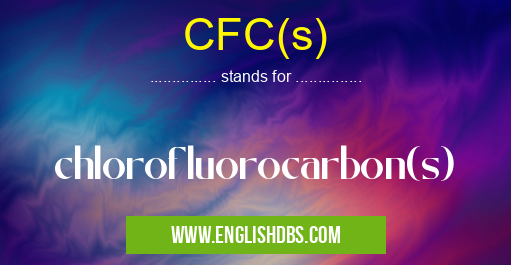What does CFC(S) mean in CHEMISTRY
Chlorofluorocarbons, commonly known as CFCs, are molecules that contain both chlorine and fluorine atoms. These molecules were once widely used in industry and manufacturing until scientists realized their effect on the environment. The molecular structure of CFCs causes them to rise into the atmosphere where they can deplete the ozone layer that protects us from harmful UV radiation.

CFC(s) meaning in Chemistry in Academic & Science
CFC(s) mostly used in an acronym Chemistry in Category Academic & Science that means chlorofluorocarbon(s)
Shorthand: CFC(s),
Full Form: chlorofluorocarbon(s)
For more information of "chlorofluorocarbon(s)", see the section below.
Essential Questions and Answers on chlorofluorocarbon(s) in "SCIENCE»CHEMISTRY"
What is a chlorofluorocarbon?
A chlorofluorocarbon is a type of molecule composed of chlorine, fluorine, and carbon atoms. CFCs were initially developed in 1928 for use in refrigeration and aerosol sprays but have since been phased out due to their environmental impacts.
Where are CFCs found?
CFCs are found in many industries including production of foam insulation, synthetic rubbers, and aerosol propellants, as well as in industrial cleaning agents. They may also be produced naturally during some marine reactions.
How do CFCs affect the environment?
CFCs cause damage to the ozone layer by breaking it down when they come into contact with ultraviolet light. This can lead to increased levels of ultraviolet radiation on the Earth's surface which has been linked to various health problems like skin cancer.
What steps have been taken to reduce the release of excess CFCs?
In 1987 an international agreement called the Montreal Protocol was signed by many countries around the world in an effort to phase out and eliminate production and use of CFCs globally by 2030. Additionally, many countries have implemented laws limiting or banning use of these chemicals in products sold within their borders.
Are there any alternatives for using CFC-based products?
There are several alternatives available for replacing products containing CFCs such as hydrofluorocarbons (HFCs). HFCs do not contain chlorine so they do not deplete ozone but still have high global warming potential which means they should be limited or replaced with more eco-friendly options whenever possible.
Final Words:
While it is impossible to undo all of the damage caused by decades of irresponsible use and production of chlorofluorocarbons (CFCs), steps can still be taken towards restoring our planet's fragile ecosystem through careful regulation and responsible usage wherever possible.
